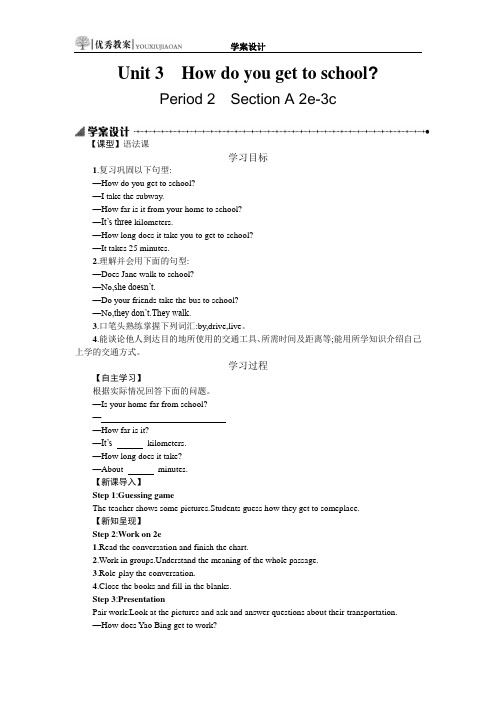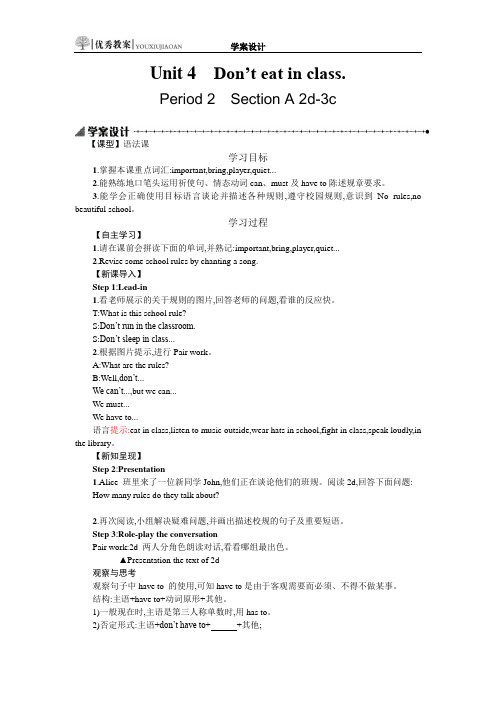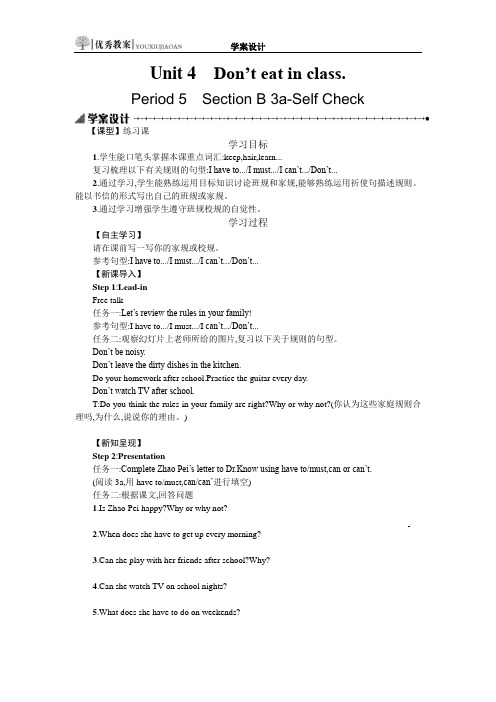最新人教版七年级下册英语全国英语素养大赛一等奖教学设计2.4
- 格式:docx
- 大小:636.58 KB
- 文档页数:5


Unit 3How do you get to school?Period 2Section A 2e-3c【课型】语法课学习目标1.复习巩固以下句型:—How do you get to school?—I take the subway.—How far is it from your home to school?—It’s three kilometers.—How long does it take you to get to school?—It takes 25 minutes.2.理解并会用下面的句型:—Does Jane walk to school?—No,she doesn’t.—Do your friends take the bus to school?—No,they don’t.They walk.3.口笔头熟练掌握下列词汇:by,drive,live。
4.能谈论他人到达目的地所使用的交通工具、所需时间及距离等;能用所学知识介绍自己上学的交通方式。
学习过程【自主学习】根据实际情况回答下面的问题。
—Is your home far from school?——How far is it?—It’s kilometers.—How long does it take?—About minutes.【新课导入】Step 1:Guessing gameThe teacher shows some pictures.Students guess how they get to someplace.【新知呈现】Step 2:Work on 2e1.Read the conversation and finish the chart.2.Work in groups.Understand the meaning of the whole passage.3.Role-play the conversation.4.Close the books and fill in the blanks.Step 3:PresentationPair work:Look at the pictures and ask and answer questions about their transportation.—How does Yao Bing get to work?—He rides a bike to work every day./He gets to work by bike every day.【新知学习】Step 4:Grammar Focus1.阅读Grammar Focus中的句子,感知句型结构。

Unit 4Don’t eat in class.Period 2Section A 2d-3c【课型】语法课学习目标1.掌握本课重点词汇:important,bring,player,quiet...2.能熟练地口笔头运用祈使句、情态动词can、must及have to陈述规章要求。
3.能学会正确使用目标语言谈论并描述各种规则,遵守校园规则,意识到No rules,no beautiful school。
学习过程【自主学习】1.请在课前会拼读下面的单词,并熟记:important,bring,player,quiet...2.Revise some school rules by chanting a song.【新课导入】Step 1:Lead-in1.看老师展示的关于规则的图片,回答老师的问题,看谁的反应快。
T:What is this school rule?S:Don’t run in the classroom.S:Don’t sleep in class...2.根据图片提示,进行Pair work。
A:What are the rules?B:Well,don’t...We can’t...,but we can...We must...We have to...语言提示:eat in class,listen to music outside,wear hats in school,fight in class,speak loudly,in the library。
【新知呈现】Step 2:Presentation1.Alice 班里来了一位新同学John,他们正在谈论他们的班规。
阅读2d,回答下面问题:How many rules do they talk about?____________________________________________________________________2.再次阅读,小组解决疑难问题,并画出描述校规的句子及重要短语。

Unit 4Don’t eat in class.Period 5Section B 3a-Self Check【课型】练习课学习目标1.学生能口笔头掌握本课重点词汇:keep,hair,learn...复习梳理以下有关规则的句型:I have to.../I must.../I can’t.../Don’t...2.通过学习,学生能熟练运用目标知识讨论班规和家规,能够熟练运用祈使句描述规则。
能以书信的形式写出自己的班规或家规。
3.通过学习增强学生遵守班规校规的自觉性。
学习过程【自主学习】请在课前写一写你的家规或校规。
参考句型:I have to.../I must.../I can’t.../Don’t...【新课导入】Step 1:Lead-inFree talk任务一:Let’s review the rules in your family!参考句型:I have to.../I must.../I can’t.../Don’t...任务二:观察幻灯片上老师所给的图片,复习以下关于规则的句型。
Don’t be noisy.Don’t leave the dirty dishes in the kitchen.Do your homework after school.Practice the guitar every day.Don’t watch TV after school.T:Do you think the rules in your family are right?Why or why not?(你认为这些家庭规则合理吗,为什么,说说你的理由。
)______________________________________________________________________【新知呈现】Step 2:Presentation任务一:Complete Zhao Pei’s letter to Dr.Know using have to/must,can or can’t.(阅读3a,用have to/must,can/can’进行填空)任务二:根据课文,回答问题1.Is Zhao Pei happy?Why or why not?________________________________________________________________________2.When does she have to get up every morning?________________________________________________________________________3.Can she play with her friends after school?Why?________________________________________________________________________4.Can she watch TV on school nights?________________________________________________________________________5.What does she have to do on weekends?________________________________________________________________________6.Does she have any fun?________________________________________________________________________ 【新知学习】Step 3:Reading activity课堂探究一任务一:Can you list the rules of Zhao Pei’s family and school?(你能罗列出Zhao Pei家里和学校的规则吗?)1.2.3.4.5.6.任务二:T:If you are Zhao Pei,will you be happy?Why or why not?(如果你是Zhao Pei,你会开心吗,为什么?)课堂探究二Complete the chart with the rules in your home and school.Put an × for the rules you think are unfair.课堂探究三Writing TaskWrite a letter to Dr.Know.Tell him about all the rules and how you feel about them.Ask two students to come to the blackboard and write the passage.语言提示:I have to...I must...I can’t...Don’t...Dear Dr.Know,There are too many rules in my life!________________________________________________________________________ ________________________________________________________________________ ________________________________________________________________________ ________________________________________________________________________ 课堂探究四Read and translate the given phrases.(读并且翻译这些词组。


Unit 2What time do you go to school?Period 5Section B 3a-Self Check【课型】写作复习课学习目标1.复习巩固表示日常生活及作息习惯的词汇和语言结构,灵活运用what time和when引导的疑问句询问时间;运用数词表达时间,巩固频率副词的用法。
2.根据3a中的范文,综合运用本单元所学的知识及写作方法描述自己的或他人的作息时间安排和活动计划,并学会分辨健康和非健康的生活方式。
3.学会合理安排自己的生活和作息。
学习过程【自主学习】根据汉语提示补全短文。
I usually1(起床)at six o’clock.I have milk and bread for breakfast.After breakfast,I2(洗澡)and then I 3(上学)by bus.I get to school at a quarter to eight.I have five classes in the morning.And then I have lunch at twelve o’clock.In the afternoon I have two classes.I 4 (回家)at half past four.I get home at 5:00.I5(吃晚饭)at about 6:00.After dinner,I6(做作业).I 7(睡觉)at 8:00.My life is busy but not exciting.【新课导入】Step 1:Lead-in1.Greetings2.Check the homework.3.Retell the passage in 2b.4.Sing a song.Get up,get up.I get up at six.Go to school,go to school,I go to school at seven.Have lunch,have lunch,I have lunch at twelve.Go home,go home,I go home at four.Go to bed,go to bed,I go to bed at night.【新知呈现】Step 2:PresentationFree talkA:Do you think you have a healthy lifestyle?B:Yes,I do./No,I don’t.A:Why do you say so?B:Because I usually get up at 6:00 in the morning.I...(谈谈生活作息安排)【新知学习】Step 3:Reading:Work on 3aLearning Tips(方法指导):First,read all of the sentences and try to understand the meaning of each sentence.We can find easily that the passage tells about his activities at different times.So students should put them in right order according to times.The first sentence is given,and the second one should be “get up”.观察与思考认真阅读3a,你会发现:I have a very healthy life.是句。
Unit 3How do you get to school?Period 5Section B 3a-Self Check【课型】写作复习课学习目标通过学习,你能:1.复习巩固所学的有关上学话题的动词词汇和介词短语。
2.练习运用how,how long,how far 和复习when引导的特殊疑问句及回答。
3.练习运用It is...kilometers.和It takes...minutes,并进行比较。
4.在实际情景中运用所学的知识能就自己上学所使用的交通方式进行简单写作。
5.通过介绍自己的上学方式和感受增进同学间的了解,同时了解美国学生的出行方式,初步形成跨文化学习意识。
学习过程【自主学习】一、请在课前总结出有关交通工具的词汇并熟记。
Means of transportation二、和同伴一起自编有关上学情况的对话,看谁的问答更清楚明白!________________________________________________________________ ________________________________________________________________ ________________________________________________________________ 【新课导入】Step 1:Pair workWork in pairs,ask and answer the questions below.(学生可以根据示范,自由发挥。
)A:How do you get to school?B:I...to...A:How long does it take to get to school?B:It takes...A:How far is it from your home to school?B:It is...【新知呈现】Step 2:PresentationLook at some pictures and a video.How do American students get to school?【新知学习】Step 3:Reading 3a1.Read the e-mail and fill in the blanks with the words in the box.Hi there,How are you?Thanks for your last e-mail.You want to know how I school,right?Well,Iusually my home at about 8:00 and to the bus stop.The school bus usually comes at about 8:15.My school is about 20 from my home.It about 40 minutes to get there by bus.The bus ride is never because I always talk to my classmates.What about you?How do you get to school?Tom2.Read and complete the chart.When How How far How long How is the trip3.Read and understand the sentence.It takes 40 minutes to get there by bus.译:4.Retell Tom’s trip to school with the help of the key words.Tom leaves home at...He walks...Step 4:Pair workLook at the five questions in 3b,and talk with your partner.A:When do you leave home?B:I usually leave home at...A:How do you get to school?B:I ride/take/walk...(I go/get to school by...)A:How far is it from your home to school?B:It is...A:How long does it take to get to school?B:It takes...A:How is your trip to school?Step 5:Enjoy readingRead the e-mail and answer the questions.Dear Tom,How are you?I want to tell you how I get to school.Well,I usually leave my home at 6:40 and walk to the bus stop.Then I take the No.8 bus to my school.It is about ten kilometers from my home to school.It takes about 20 minutes to get to school.I am very happy to go to school by bus because I can meet my classmates,but I must get up early,so sometimes I am tired.Do you think so?Mrs.Wang(1)When do I leave home?________________________________________________________________(2)How do I get to school?________________________________________________________________(3)How far is it from my home to school?________________________________________________________________(4)How long does it take?________________________________________________________________(5)How is my trip to school?________________________________________________________________ 观察与思考观察语篇,本文文体为,其结构为部分。
Unit 2What time do you go to school?Period 4Section B 2a-2c【课型】阅读课学习目标1.在语境中理解下列词汇的含义:quickly,either,either...or...,lot,lots of,taste。
2.运用略读(scanning)、扫读(skimming)和细读(intensive reading)等阅读技巧,基本理解语篇意义,获取有效信息,分清健康的习惯和不健康的习惯。
3.通过自主阅读短文,综合运用本单元所学习的谈论日常活动安排的句型、正确的时间描述、恰当的频率副词介绍自己的活动时间,养成良好的日常生活及作息习惯。
学习过程【自主学习】一、英汉互译。
1.在下午2.在傍晚、晚上3.回家4.have breakfast5.eat dinner6.很快地7.对……有好处8.要么……要么……9.大量;许多10.有时11.品尝,尝起来12.go to bed early13.eat ice-cream14.eat quickly15.eat vegetables16.play sports17.take a walk二、请将下列习惯分类,哪些健康,哪些不健康?go to bed early,eat ice-cream,eat quickly,eat vegetables,play sports,take a walk1.healthy:2.unhealthy:【新课导入】Step 1:Lead-inTask 1 T:What time do you usually get up?(what time 侧重时间点)Task 2 T:When do you usually eat breakfast?(when可询问时间段或时间点)S:...T:Now please ask and answer in pairs.Student A:...Student B:...【新知呈现】Step 2:Presentation1.T:In our lives,some activities are healthy.For example:Take a walk after dinner.Exercise every morning.Go to bed early and get up early.2.BrainstormingLet’s work in groups.Talk about what a ctivities are healthy;what activities are unhealthy. Make a list on a piece of paper.Then report your list to the class.3.Look at the activities,which are healthy and which are not.get up early eat ice-cream after dinnergo to bed late don’t brush t eetheat very quickly brush teeth after dinnerrun in the morning sometimes play sportstake a walk after dinner exercise before afternoon class【新知学习】Step 3:ReadingBefore reading1.Look at 2a and read the activities.2.Check the activities in 2a you think are healthy.While readingScanningRead quickly and answer the questions:1.Who are they?2.Who is healthier?3.When does Tony go to bed?4.When does Mary go to bed?Students read the passage quickly and try to find the answers to the questions. SkimmingTime Mary’s ActivitiesIntensive reading1.Students read the passage again and circle the healthy activities in the passage.2.Check the answers.3.Tell the students to read the passage again and write down the unhealthy habits of each person.Then think of healthy activities for them.Unhealthy habits Healthy activitiesTonyMary观察与思考通读全文,本文以为线索,贯穿全文,如:in the morning,,;另外一些时间短语,如:at ten thirty,等;除此以外,一些关联词,如:so,,等也可以使语言描述更有层次、更完整。
After reading1.Listen to the tape and read after the tape.(Teacher plays the tape and pauses it sentence by sentence for students to repeat.)2.Read the text loudly to your partner.3.Retell the text.(用第三人称)Tony doesn’t have a healthy lifestyle.He gets up late...4.Help Tony.Discuss in groups to design a new and healthy schedule for Tony.Step 4:Pair workImagine you are a famous movie star.1.Fill in the timetable with the things you usually do.2.Share the information with your partners.3.Think about whether your habits are healthy or not and think of some advice for each other.Activities Times(设计意图:让学生通过角色扮演介绍自己的日常安排。
运用任务型教学引导学生在活动中学习语言,并提高学生学习的主动性和积极性。
培养学生综合运用语言的能力。
) Step 5:WritingAccording to your chart,write down something about your day.(注意使用频率副词)I think I have healthy/unhealthy habits.I usually get up at...___________________________________________________________________________ ___________________________________________________________________________ ___________________________________________________________________________ 【课堂练习】一、完形填空。
John is a Canadian.He lives in a tall building.He gets up at 1every morning.He 2 home at seven o’clock.And he gets to school at seven forty.He has 3classes in the morning and two in the 4.After school,he likes to play volleyball 5his classmates.He goes home at five thirty 6.He and his 7have dinner 8home.9he does his homework.He goes to 10at around nine thirty.What a busy day!1.A.eight forty B.six fortyC.seven fourteenD.seven forty2.A.goes B.getsesD.leaves3.A.eight B.tenC.fourD.twelve4.A.morning B.eveningC.nightD.afternoon5.A.and B.withC.toD.like6.A.a.m. B.p.m.C.in afternoonD.in the morning7.A.teachers B.mothersC.parentsD.students8.A.at B.inC.outD.behind9.A.When B.ThenC.HowD.Why10.A.bed B.the bedC.a bedD.be二、根据汉语提示完成句子。
1.我没有多少时间吃早餐,因此我通常吃得很快。
I don’t have for breakfast,so I usually .2.他晚上或者看电视或者玩电脑游戏。
He watches TV plays computer games the .3.午餐,她吃很多的水果和蔬菜。
For ,she fruit and vegetables.4.冰激凌尝起来很好,但对她没好处。
Ice-cream ,but it’s not her.5.在晚上,我通常游泳或散步。
In the ,I usually or .6.他有时候会打半个小时的篮球。
He plays basketball an hour.自我反思1.我的收获:Words and expressions:Sentences:2.学习本节后,我能用英语进行:3.我的易错点:参考答案【自主学习】一、1.in the afternoon2.in the evening3.go home4.吃早饭5.吃晚饭6.quickly7.be good for8.either...or...9.lots of10.sometimes11.taste12.早睡13.吃冰激凌14.快速吃15.吃蔬菜16.做运动17.散步二、1.healthy:go to bed early,eat vegetables,play sports,take a walk2.unhealthy:eat ice-cream,eat quickly【课堂练习】一、1~5 BDCDB6~10 BCABA二、1.much time;eat very quickly2.either;or;in;evening3.lunch;eats lots of4.tastes good;good for5.evening;swim;take a walk6.sometimes;for half。